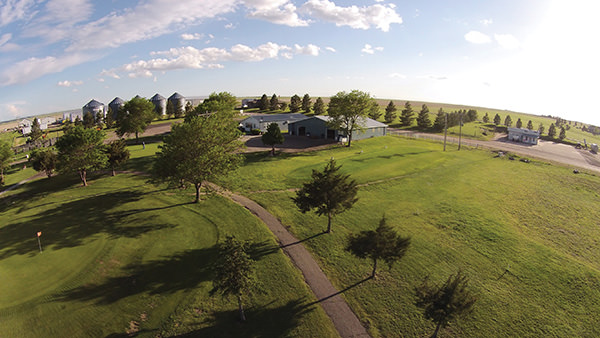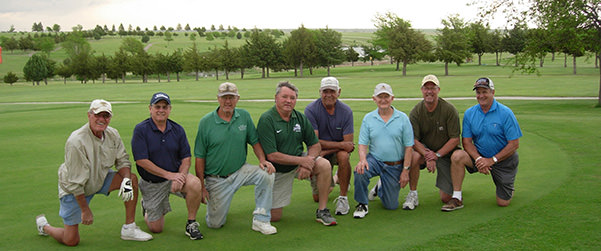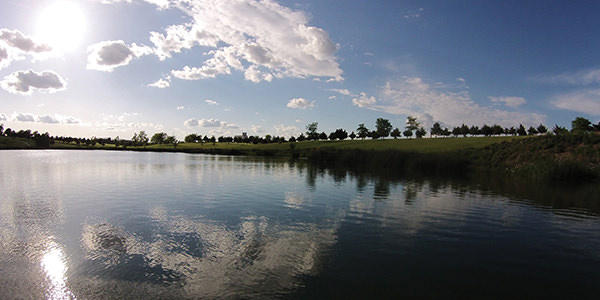RODEO DUNES: A NEW SHERIFF IN TOWN
The Colorado private-club solar system is about to see a giant new planet come into orbit

On July 29, 144 golfers, some coming from as far away as Florida, will tee off under the Colorado sun in a two-day tournament many of them call the highlight of their summer. Sixty of them will have arrived early to compete in the previous day’s horse race, the shootout that doubles as a practice round.
The Stop & Shop Tournament has sold out every year since it started in 1989. Its popularity has necessitated two flights and the creation of a waiting list. While golf tournaments that regularly take place at Sanctuary and other coveted Colorado venues can boast similar records of success, the Stop & Shop traverses the buffalo-grass fairways of Mossland Memorial Golf Course, a homegrown, nine-hole layout in the tiny town of Flagler, a half-hour east of Limon on I-70.
Mossland’s flags sprout to the south of exit 395. To the north, beyond the teed-up pink Cadillac outside the I-70 Diner, lies downtown Flagler, “a friendly, caring, historic community,” according to the welcome sign. Adjacent to the freight tracks of the old Rock Island Railroad line, the local co-op’s grain elevator and silos stand tall against the sky—monuments to the agricultural pride that built this century-old town of curbed and guttered streets lined by sun-bleached one- and two-story buildings.
Two of those structures figure prominently in the tournament. After the Saturday rounds have concluded, the American Legion Post 81 welcomes the entire field (and guests for an additional fee) to a rather wet T-Bone-and-baked-potato dinner followed by a spirited Calcutta with a professional auctioneer from Wray.

A block west is the other building—the Stop & Shop Super Market that gives the tournament its name. Tony and Debby Ford have owned the 65-year-old market for more than four decades. They also own two more—in Limon and in Stratton. The Flagler store is the flagship. The Fords—especially Tony—don’t really sponsor the tournament as much as they own and operate it. They plow all the proceeds from the $110-per-person entry fees and their 10 percent Calcutta cut back into maintaining Mossland Memorial.
You can’t blame Tony for feeling a strong sense of proprietorship over the course. After all, between 1985 and 1987, with help from the entire town, he and a core group of golf aficionados—among them D.C. Moss, Ed Ward, Jerry Balman, Tony Lorince, Ron Wieser, Randy Fagerlund, Jess Elrick, Ivan Stahlecker, Tom Bredehoft and Tom Arensdorf—built the place.“We’re all in our sixties and seventies now, but back then we were getting to the point where we could just about still play fast-pitch softball,” Tony says. A round of golf required at least a 30-minute drive to a nine-holer in Limon or Stratton, or to a sand-green course in Hugo, Cope or Kirk. Burlington was a bit further; Eads and Akron, further still.“We thought it would be great to have our own course right here in Flagler,” Tony says. In the summer of 1985, they called a town meeting, resolved some matters and incorporated as “The Flagler Golf Club, Inc.” D.C. Moss, one of the officers, convinced his parents, Don and Helen Moss, to provide 87 acres of pastureland for the course. Mossland Memorial would be named in their honor.

The group asked three local members of the USDA’s Soil Conservation Service to help lay out nine holes, which would have two sets of tees in order to create different front- and back-nine experiences. Non-irrigated native buffalo grass would cover in the fairways and rough. They’d put bluegrass on the teeing areas and bentgrass on the greens, running irrigation from a pond on the property.
Civic enthusiasm for the project ran high in the town of 550. “We sold 126 lifetime charter memberships and made $140,000,” Ford remembers. “We had 70- and 80-year-olds who bought in, and many of those people never even played golf. They did it for Flagler.” Residents also volunteered thousands of hours on weekday evenings and during long days on the weekends, using their own farm equipment to help plant hundreds of trees, dig trenches and shape the course. Even with all the free labor and equipment, construction still cost $40,000. Most of it went towards pipes and irrigation equipment, hundreds of trees to line the fairways, topsoil, peat moss, grass seed and 218,000 yards of sand for the greens mixture.
Not wanting pancake greens, the Flagler team brought in Neal Johnson, then the superintendent at Collindale Golf Course in Fort Collins to consult. Johnson had built the greens at Collindale and at Eaton Country Club. (To get an idea of the quality of its greens, Collindale held its 14th straight local U.S. Open qualifier this year.) “He saw and liked what we were doing with the course, but he said we absolutely had to increase the size of the greens and add a lot more undulation,” Ford remembers. “We hauled in another 200 tons of dirt.” It was worth it. According to 5-handicap Mike Petrelli of Littleton, who regularly plays in the Stop & Shop Tournament with Tony and Tony’s son Trey, the bentgrass greens can be “extremely tricky, with plenty of fun, hard pin positions.” The remaining $100,000 in membership dues went into the bank; back in 1987, the yield on a $100,000 CD could apparently provide enough income to maintain a nine-hole golf course. The course opened August 13, 1987, with 75 people attending the ribbon cutting. Players could register at an existing building on the property, which also housed a few golf carts. The Flagler News praised the “strong leadership and cooperation from many men and women who recognized the need for more recreational facilities … Those who do not play golf can be proud of their community for providing the course for those who will enjoy it.”

Over the course of the ensuing three decades, Mossland Memorial has brought much enjoyment to the residents of Flagler. There’s a modest clubhouse with a part-time starter who can provide a metal bucket of range balls and a cart if desired. Maintenance equipment is either donated or bought at auction. Members store their carts in a larger structure next door. You probably won’t need a cart, but the course is far hillier than you’d expect. The two nines comprise a 5,946-yard, par-70 course with 67.7/108 slope rating. In case the starter’s not around, an honor box on the first tee collects green fees ($10 for nine holes; $20 for 18).
Local rules allow lifting and placing your ball in the wide fairways, especially when the buffalo grass is thick from the rain. Don’t expect to take divots. Every green has a false front, and water—in the form of the central lake and connected tributaries—factors into holes one, three, four, five and nine. Particularly in the afternoon, the wind can howl. Flagler should be proud of the course its residents built. It opens with three par 4s. Avoid the stream bisecting the 300-yard first hole and you’re looking at a birdie or par. The second doglegs hard right with no chance of cutting it. The lake sits left of to the teebox and fairway on hole 3, and the fairway cants towards the water. Mossland’s signature hole is the par-5 5th, where the green tucks just beyond a hollow in which water often collects, making this a definite lay up hole. The par-3 6th features a green that makes a tabletop look big, while the 7th ascends so steeply only the top of the flagstick and the pines surrounding it are visible from the tee. Most of the holes play longer the second time around—most dramatically when the 510-yard 8th becomes the 606-yard 17th. “It’s called ‘Super 8’ for a reason,” says Petrelli, who with the wind blowing during last’s year’s tournament hit driver-driver-hybrid and still came up short of the green. When it becomes hole 18, hole 9 jumps from 271 to 336 yards—all of them straight uphill and usually into the wind.
Only about 20 of the 126 charter members remain from 1987, and two of the original nucleus, Ivan Stahlecker and Tom Arensdorf, handle course maintenance as volunteers. The Stop & Shop Tournament Tony started in 1989 generates much of the operating revenue that bank CDs no longer do. Local businesses hold similar tournaments to benefit Mossland. Although the course never gets too crowded, an increasing number of younger people—many close to the same age as Tony Ford when the course opened—participate in evening men’s and couples leagues. Some have joined the board, meaning a succession plan already has begun. Those folks play in the Stop & Shop event, which produces an economic impact to the area of around $25,000. “The golf course has just had such a great impact on the community,” Ford says. “Flagler means everything to me.”
Call 719-765-4659 for information. To see a video of Mossland Memorial, go to its page at coloradoavidgolfer.com/courses.
This article appears in the July 2017 issue of Colorado AvidGolfer, the state’s leading resource for golf and the lifestyle that surrounds it, publishing eight issues annually and proudly delivering daily content via coloradoavidgolfer.com.
The Colorado private-club solar system is about to see a giant new planet come into orbit
Boy Scout turns to golf to help honor the Greatest Generation
Renate Shafer of Castle Rock scores hole-in-one at The Links in Highlands Ranch
3 Common Errors and 3 Drills to Help You Improve